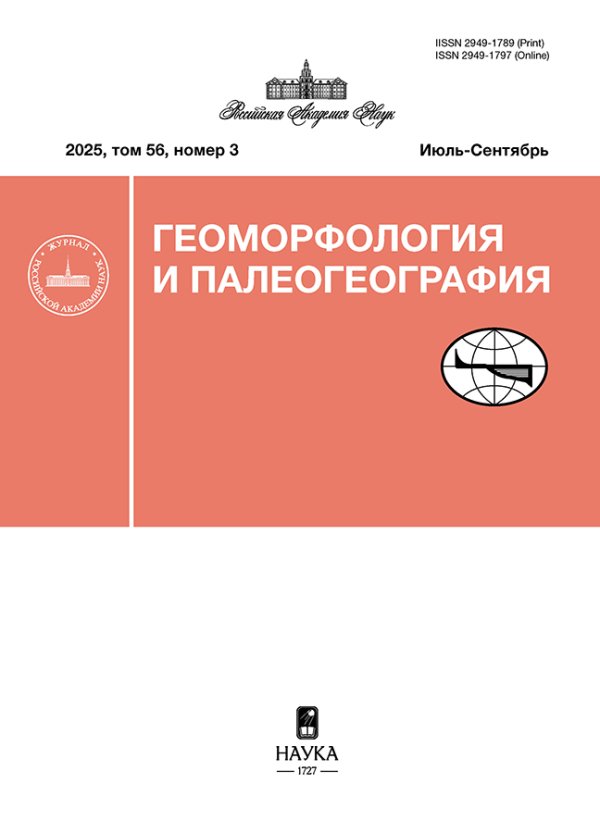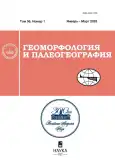Hydrological and climatic characteristics of the Caspian Sea during the last glacial maximum, mid-holocene and pre-industrial conditions according to numerical modelling data
- Authors: Morozova P.A.1, Ushakov K.V.2, Semenov V.A.1,3, Volodin E.M.4, Ibrayev R.A.2,4
-
Affiliations:
- Institute of Geography RAS
- Shirshov Institute of Oceanology RAS
- Obukhov Institute of Atmospheric Physics RAS
- Marchuk Institute of Numerical Mathematics RAS
- Issue: Vol 56, No 1 (2025): SPECIAL ISSUE
- Pages: 130-146
- Section: THE CASPIAN SEA IN THE PLEISTOCENE: EVOLUTION OF THE NATURAL ENVIRONMENT AND HUMANS
- URL: https://ogarev-online.ru/2949-1789/article/view/305385
- DOI: https://doi.org/10.31857/S2949178925010079
- EDN: https://elibrary.ru/dnwwvy
- ID: 305385
Cite item
Abstract
Components of the water balance of the Caspian Sea are calculated for a wide range of lake levels (–85– 50 m. a. s. l.) and for the two most contrasting climatic epochs over the last several tens of thousands of years: the middle Holocene (6 ka b. p.) and the Last Glacial Maximum (21 ka b. p.), as well as for the pre-industrial conditions (~1850). The eddy-resolving ocean general circulation model INMIO coupled with the CICE ice model are used for the calculations. Climate data of the INM–CM4.8 model for the indicated periods are used as boundary conditions. It is found that the volumes of river inflow required to maintain the lake level at various marks for the Holocene era are lower than the corresponding pre-industrial values by 6–7%. For the Last Glacial Maximum this decrease is 13–14% for regressive states and 20–21% for transgressive ones. Sensitivity of the results is studied to the temporal resolution of boundary meteorological data and to the locations of fresh water inflow into the Caspian Sea. It is shown that excluding the diurnal and intramonthly variability in input data leads to an underestimation of evaporation from the surface of the sea. The greatest influence on this value is exerted by the exclusion of intramonthly variability of the dynamic wind field: this leads to a decrease in the equilibrium runoff by 35%. To correctly simulate the duration of the ice coverage season, it is necessary to take into account the diurnal cycle of incoming radiation and air temperature. The melting period is significantly lengthened when using data at daily or monthly resolution, which has the greatest impact during transgressive states of the Caspian Sea. The redistribution of river mouth locations along the coast does not significantly affect the value of the total equilibrium inflow, which makes it possible to most likely exclude the uncertainty of this value associated with the lack of data on the mutual ratio of discharge of ancient rivers. In addition, estimates of hydroclimatic characteristics of the Caspian region for the middle Holocene and late Pleistocene are provided based on climate modeling carried out within the framework of the PMIP4 project.
About the authors
P. A. Morozova
Institute of Geography RAS
Email: morozova_polina@mail.ru
Moscow, Russia
K. V. Ushakov
Shirshov Institute of Oceanology RAS
Email: morozova_polina@mail.ru
Moscow, Russia
V. A. Semenov
Institute of Geography RAS; Obukhov Institute of Atmospheric Physics RAS
Email: morozova_polina@mail.ru
Moscow, Russia; Moscow, Russia
E. M. Volodin
Marchuk Institute of Numerical Mathematics RAS
Email: morozova_polina@mail.ru
Moscow, Russia
R. A. Ibrayev
Shirshov Institute of Oceanology RAS; Marchuk Institute of Numerical Mathematics RAS
Author for correspondence.
Email: morozova_polina@mail.ru
Moscow, Russia; Moscow, Russia
References
- Argus D.F., Peltier W.R., Drummond R. et al. (2014). The Antarctic component of postglacial rebound Model ICE-6G_C (VM5a) based upon GPS positioning, exposure age dating of ice thicknesses and sea level histories. Geophys. J. Int. Vol. 198. No. 1. P. 537–563. https://doi.org/10.1093/gji/ggu140
- Brierley C.M., Zhao A., Harrison S.P. et al. (2020). Large-scale features and evaluation of the PMIP4–CMIP6 mid-Holocene simulations. Climate of the Past. Vol. 16. Iss. 5. P. 1847–1872. https://doi.org/10.5194/cp-16-1847-2020
- Elguindi N., Somot S., Deque M. et al. (2011). Climate change evolution of the hydrological balance of the Mediterranean, Black and Caspian Seas: impact of climate model resolution. Climate Dynamics. Vol. 36. P. 205–228. https://doi.org/10.1007/s00382-009-0715-4
- Fadeev R., Ushakov K., Tolstykh M. et al. (2018). Design and development of the SLAV–INMIO–CICE coupled model for seasonal prediction and climate research. Russian J. of Numerical Analysis and Mathematical Modelling. Vol. 33. No. 6. P. 333–340. https://doi.org/10.1515/rnam-2018-0028
- Garstang M. (1967). Sensible and latent heat exchange in low latitude synoptic scale systems. Tellus. Vol. 19. Iss. 3. P. 492–508. https://doi.org/10.1111/j.2153-3490.1967.tb01504.x
- Gelfan A., Panin A., Kalugin A. et al. (2024). Hydroclimatic processes as the primary drivers of the Early Khvalynian transgression of the Caspian Sea: new developments. Hydrol. Earth Syst. Sci. Vol. 28. Iss. 1. P. 241–259. https://doi.org/10.5194/hess-28-241-2024
- Giorgi F. (2019). Thirty years of regional climate modeling: Where are we and where are we going next? J. Geophys. Res.: Atmos. Vol. 124. P. 5696–5723. https://doi.org/10.1029/2018JD030094
- Griffies S.M., Biastoch A., Böning C. et al. (2009). Coordinated Ocean-ice Reference Experiments (COREs). Ocean Modelling. Vol. 26. Iss. 1-2. P. 1–46 https://doi.org/10.1016/j.ocemod.2008.08.007
- Hajima T., Watanabe M., Yamamoto A. et al. (2020). Development of the MIROC-ES2L Earth system model and the evaluation of biogeochemical processes and feedbacks. Geosci. Model Dev. Vol. 13. Iss. 5. P. 2197–2244. https://doi.org/10.5194/gmd-13-2197-2020
- Hunke E.C., Lipscomb W.H., Turner A.K. et al. (2015). CICE: the Los Alamos Sea Ice Model. Documentation and Software User’s Manual Version 5.1. Los Alamos National Laboratory. 116 p. http://www.ccpo.odu.edu/~klinck/Reprints/PDF/cicedoc2015.pdf (access date: 04.04.2024).
- Kageyama M., Albani S., Braconnot P. et al. (2017). The PMIP4 contribution to CMIP6 – Part 4: Scientific objectives and experimental design of the PMIP4–CMIP6 Last Glacial Maximum experiments and PMIP4 sensitivity experiments. Geosci. Model Dev. Vol. 10. Iss. 11. P. 4035–4055. https://doi.org/10.5194/gmd-10-4035-2017
- Kageyama M., Harrison S.P., Kapsch M.-L. et al. (2021). The PMIP4 Last Glacial Maximum experiments: preliminary results and comparison with the PMIP3 simulations. Climate of the Past. Vol. 17. Iss. 3. P. 1065–1089. https://doi.org/10.5194/cp-17-1065-2021
- Kalmykov V.V., Ibrayev R.A., Kaurkin M.N. et al. (2018). Compact Modeling Framework v3.0 for high-resolution global ocean–ice–atmosphere models. Geosci. Model Dev. Vol. 11. Iss. 10. P. 3983–3997. https://doi.org/10.5194/gmd-11-3983-2018
- Kislov A., Toropov P. (2011). Modeling extreme Black Sea and Caspian Sea levels of the past 21000 years with general circulation models. Geological Society of America Special Papers. P. 27–32. https://doi.org/10.1130/2011.2473(02)
- Koriche S.A., Singarayer J.S., Cloke H.L. et al. (2022). What are the drivers of Caspian Sea level variation during the late Quaternary? Quat. Sci. Rev. Vol. 283. 107457. https://doi.org/10.1016/j.quascirev.2022.107457
- Kurbanov R., Murray A., Thompson W. et al. (2021). First reliable chronology for the Early Khvalynian Caspian Sea transgression in the Lower Volga River valley. Boreas. Vol. 50. P. 134–146. https://doi.org/10.1111/bor.12478
- Launiainen J., Vihma T. (1990). Derivation of turbulent surface fluxes – an iterative flux–profile method allowing arbitrary observing heights. Environmental Software. Vol. 5. No. 3. P. 113–124. https://doi.org/10.1016/0266-9838(90)90021-W
- Mauritsen T., Bader J., Becker T. et al. (2019). Developments in the MPI–M Earth System Model version 1.2 (MPI–ESM1.2) and its response to increasing CO2. J. of Advances in Modeling Earth Systems. Vol. 11. Iss. 4. P. 998–1038. https://doi.org/10.1029/2018MS001400
- Morozova P.A., Ushakov K.V., Semenov V.A. et al. (2021). Water Budget of the Caspian Sea in the Last Glacial Maximum by Data of Experiments with Mathematical Models. Water resources. Vol. 48. No. 6. P. 823–830. https://doi.org/10.1134/S0097807821060130
- Morozova P.A., Ushakov K.V., Semenov V.A. et al. (2024). Water Balance of the Caspian Sea in the Last Glacial Maximum and Pre-Industrial Conditions Based on the Experiments with the INMIO–CICE General Sea Circulation Model. Dokl. Earth Sci. Vol. 515. Part 2. P. 675–679. https://doi.org/10.1134/S1028334X23603620
- Nesterov E.S. (Ed.). (2016). Vodnyi balans i kolebaniya urovnya Kaspiiskogo morya: modelirovanie i prognoz (Water balance and level fluctuations of the Caspian Sea. Modeling and prediction). Moscow: Triada ltd (Publ.). 378 p. (in Russ.).
- Panin G.N. (1987). Isparenie i teploobmen Kaspiiskogo morya (Evaporation and heat exchange of the Caspian Sea). Moscow: Nauka (Publ.). 88 p. (in Russ.).
- Peltier W.R., Argus D.F., Drummond R. (2015). Space geodesy constrains ice age terminal deglaciation: The global ICE-6G_C (VM5a) model. J. Geophys. Res.: Solid Earth. Vol. 120. Iss. 1. P. 450–487. https://doi.org/10.1002/2014JB011176
- PMIP4. https://pmip4.lsce.ipsl.fr/doku.php/exp_design: index (access date: 04.04.2024).
- Sidorenko D., Rackow T., Jung T. et al. (2015). Towards multi-resolution global climate modeling with ECHAM6–FESOM. Part I: model formulation and mean climate. Climate Dynamics. Vol. 44. P. 757–780. https://doi.org/10.1007/s00382-014-2290-6
- Tujilkin N.S., Kosarev A.N., Arkhipkin V.S., Nikonova R.E. (2011). Long-term variations of the hydrological regime of the Caspian Sea. Vestnik Moskovskogo universiteta. Seriya 5. Geografiya. No. 2. Р. 62–71. (in Russ.).
- Ushakov K.V., Ibrayev R.A. (2018). Assessment of mean world ocean meridional heat transport characteristics by a high-resolution model. Russ. J. Earth Sci. Vol. 18. ES1004. https://doi.org/10.2205/2018ES000616
- Volodin E.M., Mortikov E.V., Kostrykin S.V. et al. (2018). Simulation of the modern climate using the INM–CM4.8 climate model. Russian J. of Numerical Analysis and Mathematical Modelling. Vol. 33. No. 6. P. 367–374. https://doi.org/10.1515/rnam-2018-0032
- Yanina T. (2020). Environmental variability of the Ponto-Caspian and Mediterranean basins during the last climatic macrocycle. Geography, Environment, Sustainability. Vol. 13. No. 4. P. 6–23. https://doi.org/10.24057/2071-9388-2020-120
- Yanina T.A., Sorokin V., Bezrodnykh Yu. et al. (2018). Late Pleistocene climatic events reflected in the Caspian Sea geological history (based on drilling data). Quat. Int. Vol. 465. Part A. P. 130–141. https://doi.org/10.1016/j.quaint.2017.08.003
Supplementary files










